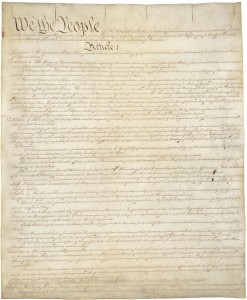Good morning, Whitewater.
Midweek in town will be sunny with a high of sixty-nine. Sunrise is 6:37 AM and sunset is 7:01 PM. The moon is a waning crescent with thirty-four percent of its visible disk illuminated.
On this day in 1787, delegates at the the Constitutional Convention sign their finished product:
Once the final modifications had been made, the Committee of Style and Arrangement was appointed “to revise the style of and arrange the articles which had been agreed to by the house.” Unlike other committees, whose members were named so the committees included members from different regions, this final committee included no champions of the small states. Its members were mostly in favor of a strong national government and unsympathetic to calls for states’ rights.[12]:229–230 They were William Samuel Johnson (Connecticut), Alexander Hamilton (New York), Gouverneur Morris (Pennsylvania), James Madison (Virginia), and Rufus King (Massachusetts). On Wednesday, September 12, the report of the “committee of style” was ordered printed for the convenience of the delegates. For three days, the Convention compared this final version with the proceedings of the Convention. The Constitution was then ordered engrossed on Saturday, September 15 by Jacob Shallus, and was submitted for signing on September 17. It made at least one important change to what the Convention had agreed to; King wanted to prevent states from interfering in contracts. Although the Convention never took up the matter his language was now inserted, creating the contract clause.[12]:243
Gouverneur Morris is credited, both now and then, as the chief draftsman of the final document, including the stirring preamble. Not all the delegates were pleased with the results; thirteen left before the ceremony, and three of those remaining refused to sign: Edmund Randolph of Virginia, George Mason of Virginia, and Elbridge Gerry of Massachusetts. George Mason demanded a Bill of Rights if he was to support the Constitution. The Bill of Rights was not included in the Constitution submitted to the states for ratification, but many states ratified the Constitution with the understanding that a bill of rights would soon follow.[14] Shortly before the document was to be signed, Gorham proposed to lower the size of congressional districts from 40,000 to 30,000 citizens. A similar measure had been proposed earlier, and failed by one vote. George Washington spoke up here, making his only substantive contribution to the text of the Constitution in supporting this move. The Convention adopted it without further debate. Gorham would sign the document, although he had openly doubted whether the United States would remain a single, unified nation for more than 150 years.[12]:112 Ultimately, 39 of the original 55 delegates ended up signing, but it is likely that none were completely satisfied. Their views were summed up by Benjamin Franklin, who said,
“I confess that There are several parts of this Constitution which I do not at present approve, but I am not sure I shall never approve them. … I doubt too whether any other Convention we can obtain, may be able to make a better Constitution. … It therefore astonishes me, Sir, to find this system approaching so near to perfection as it does; and I think it will astonish our enemies…[15]”
Google-a-Day asks a geography question:
What famous Alexandrian was responsible for the most popular map printed from movable type in the fifteenth century?

